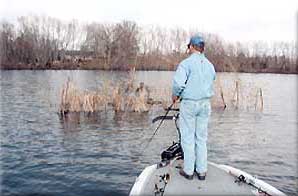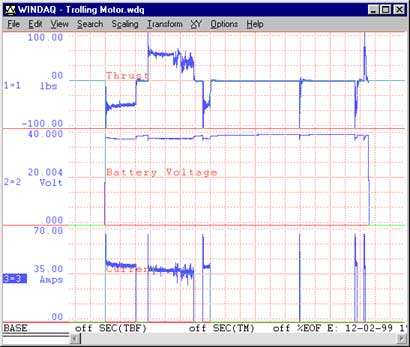Casting off with WinDaq Software and the DI-730
Sport fishermen would recognize the product immediately. Though this one was rigged to a metal tub filled with water, most fishermen are used to seeing the product attached to the bow of a bass boat where it allows the skipper to easily and quietly maneuver the boat for a shot at a trophy fish. Of course, we're talking about an electric trolling motor and our customer was engaged in running some tests on one they manufacture.
 We were called when the decision was made to upgrade their test equipment with a more contemporary solution. There are three fundamental measurements that qualify an electric trolling motor: Battery voltage, current, and thrust and our customer wanted to measure all of these simultaneously. Her current instrumentation consisted of three panel meters; one dedicated to each of the three measurement parameters. The voltage measurement was made directly across the battery terminals, the current measurement across a shunt placed in series with one of the battery cables, and thrust was measured using a load cell that simply measured how hard the motor pushed against its mount.
We were called when the decision was made to upgrade their test equipment with a more contemporary solution. There are three fundamental measurements that qualify an electric trolling motor: Battery voltage, current, and thrust and our customer wanted to measure all of these simultaneously. Her current instrumentation consisted of three panel meters; one dedicated to each of the three measurement parameters. The voltage measurement was made directly across the battery terminals, the current measurement across a shunt placed in series with one of the battery cables, and thrust was measured using a load cell that simply measured how hard the motor pushed against its mount.
The problem with the older instrumentation was that it didn't provide any recording capability. Logging was done manually using a pencil and clipboard and therefore lacked a dynamic component. Further, there was no continuity to the measurements so the engineering team wasn't able to clearly gage how battery voltage and current react to changes in thrust. They hoped to solve these problems with the new instrumentation, and chose WinDaq software and a DI-730 for the job. WinDaq software, with its excellent real-time characteristics, would instantly paint a graphical picture of the three variables. Other features would allow the engineers to plot any variable versus another for further insight concerning their interdependencies. DI-730 hardware allowed the engineers to simply clip across the transducers that were already in place. The DI-730's isolation feature allowed a trouble-free connection directly to the current shunt and across the load cell, and its wide measurement range per channel allowed them to easily control gain as needed.
This application is another example of how traditional instrumentation is replaced quickly and easily with a DATAQ Instruments solution that provides immediate results without programming.

Figure 1 — A fully compressed file showing the voltage, current, and thrust waveforms.

Figure 2 — An expanded portion of the file shown in Figure 1 showing an X-Y plot of battery current versus thrust.
Additional Reading:
DI-730 Data Acquisition System Aids Moon Roof Design and Qualification


 View Cart
View Cart sales@dataq.com
sales@dataq.com 330-668-1444
330-668-1444